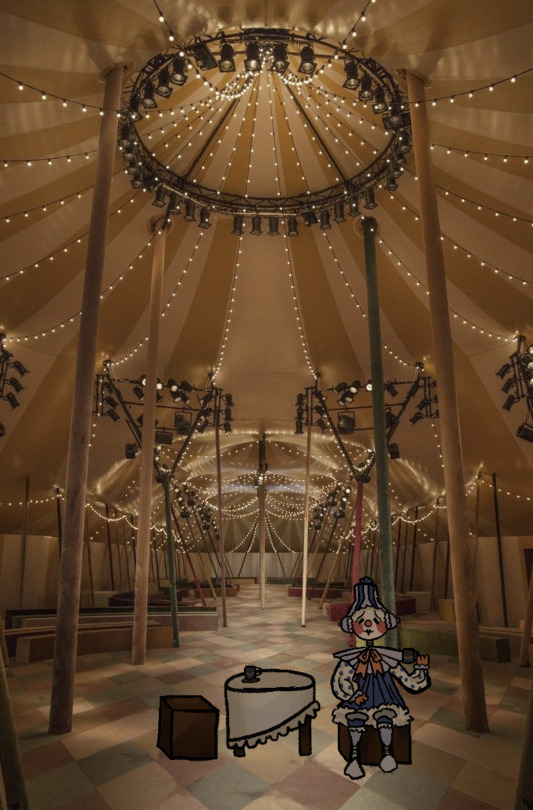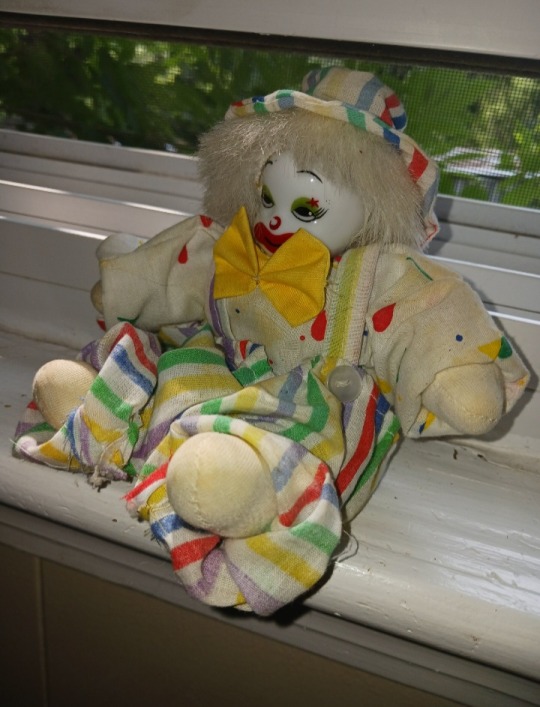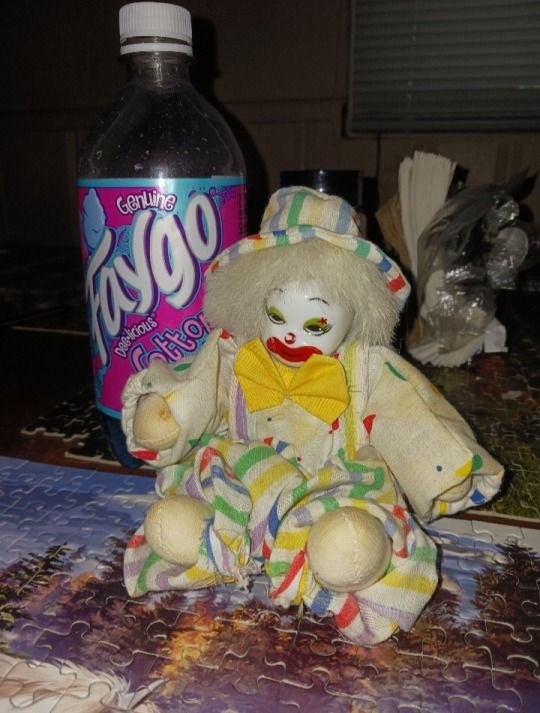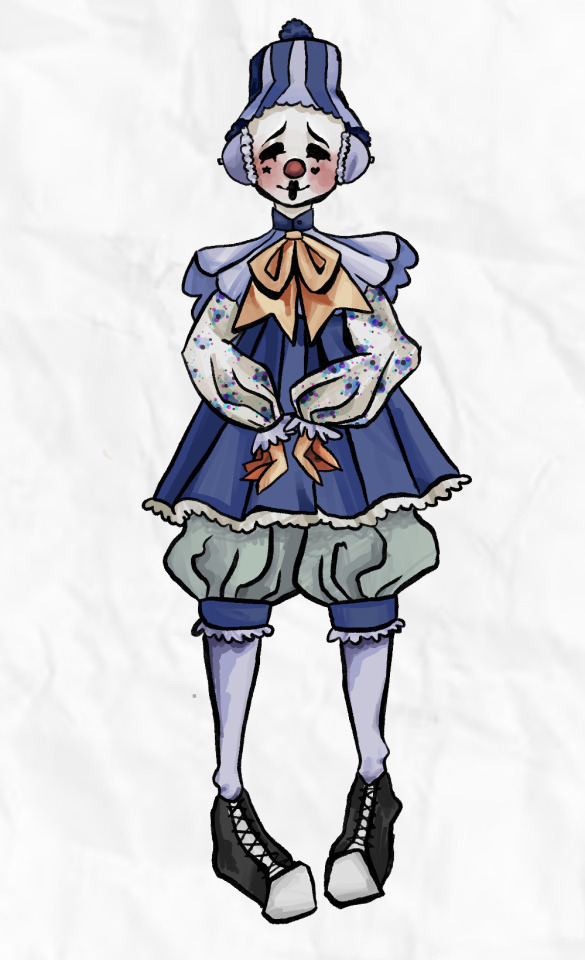#clownhusbandry
Text
My clown Clover in her tent and yes I know she needs a playmate I’m working on it lol

#clown husbandry#clownhusbandry#clown#clown care#clownblr#original art#ocs#oc art#pierrot#Sweets British Clown#clover
212 notes
·
View notes
Note

Hey
I know I just sent you an ask but
I’m planning on buying this female clown and I was wondering
If you could possibly bestow any knowledge about this pretty girl too before I receive her in October 🥺🥺
Tysm I love your imput 😁 (also give me name ideas if you have any!!! She needs a good name!!)
Ohoho, that’s a fancy looking lady right there, I’d be happy to give my two cents on her!
She seems to be a teacup, I’m slightly unsure of the scale since the background of the photo is blank. Those bells and that hat are classic jester traits, she’s got quite a lot of sequins, lace, ribbons and frill so I might even guess she’s a royal jester.
The monochromatic black and white color palette is very striking, I’m not quite sure what to make of that. Unlike with circus breeds, black and white colors don’t necessarily mean the clown is mixed with Pierrot/mime, or that the clown is from a very selectively bred lineage that’s been cultivated for those colors. Jesters can be grayscale without Pierrot/mime ancestry and it’s not extremely rare, this makes it difficult to determine whether a jester is a mime or Pierrot mix, along with the fact that pure bred jesters and pure bred Pierrot can have some similar features.
The best way to know without DNA testing is to interact with the clown in person. Jesters are witty and talkative, they can be crass and mischievous, and they don’t tend to be very shy. Pierrot are considered more ‘dainty’, they rarely vocalize (although they can, unlike mimes), they are shy and cautious, and their performances are more subtle and musical than slapstick and comedic. It shouldn’t be too difficult to observe your clown’s behavior and draw your own conclusion, but until you meet her it’s anyone’s guess what her ancestry is. (If she is mixed, it’s probably not with mime because of the info I mentioned in my last clown husbandry ask)
Whether she’s got some Pierrot DNA or she’s purely jester, her diet should consist mainly of things like hard cheeses, preserved fruits, chicken/turkey, potatoes and sweet breads. That’s not to say she can never have more staple clown foods like cotton candy or corndogs, just that it’s not what she’s meant to rely on, jesters have different nutritional needs than circus clowns, for example they require higher sodium intake. This diet generally works for jesters and jester mixes, so it’s not necessary to modify if she’s partially Pierrot.
Other than diet it’s important to get some props for her, small bells and items to juggle are a good place to start. Jesters are inquisitive and love games, puzzles and riddles are a staple of theirs. Be carful when you take her places, because of how curious they are, small jesters can wander off to explore and become near impossible to track down.
Other than that I can’t think of any advice that’s specific to her, she should settle in easily with the other clowns, the enrichment of having so many friends should be very good for her, and she probably won’t need a setup too different from theirs. Of course I’m not a vet, (sorry for hammering this into the ground lol, but it is important for anyone who isn’t familiar with me) and I’m more experienced with standard teacup party clowns, so if you notice anything wrong or odd you should take her to the vet.
And lastly, I’d be happy to give you some name suggestions!
Periwinkle comes to mind, based on those beautiful blue eyes of hers.
Quinn, because I can’t stop thinking of Harley Quinn the harlequin.
Koi, Iris, Swan, Juniper, Goose, Olive and Fawn, just because I think they sound cool.
Wow, this one was pretty long! But it was worth every minute it took, and I really hope you find it helpful, it’s always a pleasure to answer your asks.
Happy clowning <3
#clown husbandry#clownblr#clown posting#clowncore#clowns#clown#clown care#clown doll#clown dolls#clownhusbandry#clown asks#clown info#clown ask#unreality#<3333#a truly exquisite clown
68 notes
·
View notes
Text



hello fellow clown lovers! i have been lurking on clownblr for quite a while and thought it was about time i introduce my son. his name is Benjamin B. Butterbean, and i found him one night honking ominously behind my house. im not sure what breed he is, probably a mix of something. he likes to take my faygo without permission
106 notes
·
View notes
Text
Recently I stumbled upon a stray wandering in the back of a relatives property. It seems to be some sort of scare-mime pierrot mix (based on the ruffles)? It looks to be a juvenile. We think it's survived off of small game like rodents and birds, as it's a somewhat wooded area.
There was no collar so my relatives told us to leave it alone, and we did, only to discover that it followed us home. It is currently occupying an old sheep pen that we lured it into with some raw meat. It was the best we could do on short notice, but we couldn't allow it to roam free before we knew it had its shots.
Fortunately it isn't rabid or aggressive. In fact it was miming in a very friendly way. It even seemed to take a liking to my little sister, blowing her up invisible balloons. We both kept our distance of course, especially her, as she is still a child and her safety takes priority. But in the short time we've cared for it, we've grown a little attached.
I don't know much about this particular mix, and from what I can tell it's not extremely common. From what I know, mime and pierrot owners usually prefer pure breeds, so they aren't often mixed. I've looked into getting a scare clown in the past but I don't know how those traits pass on here.
Any help would be appreciated!
110 notes
·
View notes
Text
Bells the Jester
Hey Clownlr. A few weeks back, I posted about the stray Court Jester wandering around my neighborhood. First off, thank you to everyone who gave me advice on what to do about him. I really appreciate all of it and honestly really needed to hear it.
I have some great news about him. While we couldn’t find any good shelters, a family friend living nearby decided to take him in. She’s had experience raising several different breeds, including jesters and fools. Her property is very nicely sized and empty apart from her, so Bells has plenty of space to live. It probably helps that my family friend used to work at the RenFair and has a ton of medieval decor around her place.
I went over to visit on Saturday and Bells is settling in very well. He still likes to go out around the neighborhood by himself, but his new owner and I have worked together to make sure he’s safe. Neutered, gotten all of his vaccines, all of that. He got really excited when he saw me, and let me tell you, it was so comforting to hear how loud his jingling has gotten between finding him that first time and now.
I’m planning on visiting him again this weekend, and I want to bring over something special for him. His bell hat is sort of threadbare, but I think it’d be too big of a step to try giving him a new one. Anybody have any suggestions of good gifts for him? Or for my family friend. She does have all the care equipment she needs, but some of it is a little old and her last jester Curly accidentally broke her flag trumpet. I would get one of those, but they’re kind of expensive and money is tight right now. Thoughts?
#Clown#Clown husbandry#Husbandry#Clownhusbandry#Jester#Court Jester#Courtjester#Bells the Jester is the best#Happy ending#Happyending#Happy
61 notes
·
View notes
Text
getting a clown
i have been interested in clown husbandry for some years now, and would like to attempt to get a clown of my own. I will preface this, by stating that, yes, though I am a beginner, I have indeed done prior research beforehand. I am particularly interested in porcelain and glass clowns, particularly those of stained glass clowns. I have my on a good adoption center for clowns as a potential option but I want to get more experienced opinions on the matter for a beginner. I have a small dog, and not an insane amount of space for a clown, so it would be important to have something small, ideally. Thankyou in advance for any responses I get, I truly have the greatest respect for all you people here and the hard work you do educating others on clown species, new, mixed, care, stereotypes, suggestions, etcetera, I previously had an unconscious stereotyping of scare clowns and other similar clowns of the like due to their depictions in movies, though thankfully since learning more from clownblr I have been able to gain more insight and an open mind on the matter! Awaiting future responses, Niko. PS. (I may have gotten some clown species names wrong due to struggle remembering the specifics of names, my bad!)
18 notes
·
View notes
Text
Good day! I’m in a bit of a predicament.. My neighbor got her first clown a week ago. She has to move and can’t find anywhere in her price range that will let her keep her clown. She decided to give me her clown.

(https://charat.me/en/chibi/create/)
This is Kelly!! Neither of us know her breed, but I think she’s got some teacup in her as she’s teeny! If anyone could give me any advice for taking care of her, that would be a huge help!
#clown breeds#clownhusbandry#know your clowns#clowns#clownblr#clownery#teacup clown#pet clowns#coulrophobia#clown info#clowncore#cute clown#domesticated clown#clown#mutt clowns#pet clown#clown posting
7 notes
·
View notes
Text
Recently rescued clowns need help finding breed
hey guys, so I recently rescued a pair of siblings I know a lot of people will say 1 clown is already enough responsibility and 2 is to much, trust me I know. But they seemed very attached to each other and I didn't want to separate them, but onto the breed, I'd say I've had my fair share of clowns but I just cant tell what these 2 are. I've previously adopted a jester and Pierrot (not at the same time) but these guys are just so inconsistent on their traits. The brother clown has stark white hair, black makeup and he’s a sweetie, he seems maybe to be a cross breed of circus and Pierrot but his sisters traits make me think otherwise.. she is slightly aggressive but very playful, unlike her brother she is very energetic and always wants to do something, im thinking she might be a crossbreed harlequin? and she has red hair and makeup to boot but if her brother is a Pierrot that wouldn't make sense? I don't know, they're quite small and relatively young so more traits could pop up as they grow but for siblings their just very different. help is appreciated
14 notes
·
View notes
Text
I'm getting my clown from clownstairs
4 notes
·
View notes
Text
Suncatcher glass clowns info (long post)
Temperament:
Suncatcher glass clowns are not a beginner breed. They can be difficult to care for and are best suited for those with experience in fragile teacup breeds, such as porcelain. They can shatter and crack, and while they can be put back together, scars and cracks will likely stay. They are generally non aggressive, but they can be energetic and mischievous at times. They use their flat bodies to play pranks on their owner, such as hiding inside the wall. Although they often don't think before hand how to get themselves out of a hiding spot. They are very playful and enjoy to run, jump, and climb, despite the fact they could be seriously injured by not being careful. Gentle handling is recommended. They are often fearless and brave, and will try and defend you like a scare clown would. They aren't really aware of their own fragility, even after surviving a breaking/cracking. Tent Details:
Suncatcher glass clowns enjoy many surfaces amd items to climb and play on. Many soft landing pads are recommended, as they often don't realize the consequences for not sticking the landing before its too late and they break. They enjoy making art, but traditional drawing can be difficult due to limited mobility, non toxic paint is a good option. They enjoy climbing surfaces, such as ropes and chains. They love sunny windows, and placing a rope or platform in front of one Is a good idea, as they love to be In front of it and cast rainbows throughout the room. Completely clear clowns may have trouble casting as vibrant rainbows their peers, which can cause distress at times. Muted, and neutral colored toys and tent are best, as Suncatcher glass clowns love being the brightest colored thing in the room. Even if your house is brightly colored, a dull secluded area where they can be the star of the show is still great. Be careful of crevices they can become stuck in, or dangerous corners and falls. Baby proofing is often essential to making sure they don't shatter themselves or get stuck under a table.Social Interaction
Suncatcher glass clowns are a very social breed. They often form family groups, and are very friendly with outsiders. Porcelain and other Suncatcher glass clowns make the best playmates, as they less likely to cause an accidental shattering. Though larger breeds can also interact with supervision, and if they are taught about being careful and gentle, testing with an uncooked egg can help see if they are ready yet. Suncatcher glass clowns often have large clutches of up to 70 small eggs, and will often try to provide care for every egg, even if it is way too much for them to handle. They are unlikely to abandon nests, offspring, and those they consider in their "group" willingly, even if they are sick, injured, or deceased.
Food:
Suncatcher glass clowns enjoy a wide variety of foods. They eat things closer to their wild counterparts would than most clowns. They enjoy vegetables, fruits, nuts, grasses, and even some mushrooms, though you should look up if a new food is toxic before feeding it to them. They also enjoy popcorn and various sweets, although baked goods can give them intestinal issues. They are scavengers and foragers, and will eat meat and protein, but they aren't naturally hunters. They typically only hunt live prey in desperation, and this is often only observed in ferals. Genetics: Glass suncatcher clowns are more likely to hatch with missing, malformed, or non working limbs than other breeds. They can also be more prone to sight and hearing issues. The stained gene is recessive and causes translucent color. It often comes with a fragility gene, fragility often disappears a few weeks after hatching, but can persist into adult life. They have dominant trait for bright colors and plumage, recessive for pastels. The rarest type is clear and colorless, but breeding these requires a mutation that can sometimes occur when double stained gene is present. This means they often have health issues in life. They also have a recessive trait for facelessness. They habe all the functions of a faced clown, their face is just not visable. Though a mouth that isn't visible when closed has been observed opening when its time to eat. Suncatcher glass clowns are often mistreated in the breeding industry and pet trade, and can have a host of health issues. Glass suncatcher clowns have been bred to produce very large clutches. They're also valuable in the pet trade, especially if they are a carrier for stained gene or have nice colors, generally pastels are harder to produce and considered more valuable than vibrant colored clowns. Unethical Breeders often dispose of "undesirable" chucklets who can still live a long healthy life, such as those with health issues or sometimes even poor coloration. Overbreeding is also an issue, as parents that produce good offspring are bred an unhealthy amount of times. Another thing is that, like most teacup breeds, Suncatcher glass clowns don't produce much milk. This is not an issue when most teacup clowns typically only have 1-2 eggs per clutch. But with large clutches, glass suncatcher clowns can't feed their chucklets by themselves. Another thing is that Suncatcher Glass clowns are often reluctant breeders, and their eggs often taken away after being laid. This can cause distress, as the clown misses its eggs. . Taxonomy: Suncatcher Glass clowns aren't a common breed, and can be expensive from a breeder. They used to be larger, more earth toned, and with much more powerful rainbow sunbeams. They were domesticated in victorian times, as having a beautiful little glass clown to cast rainbows and do amusing tricks for guests became quite fashionable among upper class society. The rainbows casted by modern clowns are mostly just for show, but pre domesticated clowns used theirs to temporarily blind predators as a distraction to get away, similar to squid ink.
#clown#clown doll#clown husbandry#clown rescue#clown farm#clowns#porcelain clown#pet clown#clownhusbandry#clowncore
51 notes
·
View notes
Text
I'm alive

just clowns
21 notes
·
View notes
Text
Hey recently, got my first clown named Clover! She’s a Sweets British Party Clown and Pierrot mix. She exhibits traits from both, but needs a tea table like most Sweets British. However, she is very shy and is scared of other clowns, particularly larger ones she doesn’t know which is hard since she’s only 2 feet. Never aggressive, but is very skittish and I want to get another sweets British mix so she can do her teatime ritual with however, I was wondering if there’s any other mixes that would work well for her
She basically lives in a classic Pierrot tent, but there are a lot of plants. That’s why I’m worried about getting a purebred Sweets British clown because they are most comfortable in greenhouses, and I’m worried the plants will not be sufficient . 
Basically any better, not particularly loud, intimidating or big. They also need to be able to handle her housing which is a little unorthodox. Any suggestions? Btw here she is

#clown husbandry#clownhusbandry#clown#clownblr#clown care#pierrot#sweets British#Sweets British Clown
32 notes
·
View notes
Note
Hi! I was wondering when porcelain breeds fully mature? I've seen people say from 1 year upto 20? I was thinking of adopting two adorable little purebred porcelains but I wanna make sure I have the right info first.
Hello lovely anon, thank you for the ask!
Because the porcelain trait occurs in so many breeds it can be difficult to nail down exactly when a porcelain clown is fully mature. The consensus is that once it’s exoskeleton has stopped thickening, it’s a full grown clown. Breeds with longer lifespans can take more time to reach maturity, 20-25 years. Smaller breeds usually fully mature in 20 years or under. So on average, the mature age for porcelains of any breed or size is around 22.
This is not to be confused with how long it takes for their exoskeleton to harden, which happens in the first 2 years of their lives. (This could be where you heard the 1 year estimate from?) A helpful way to understand this is to think of it like how a baby’s soft skull takes time to form a permanent shape. After the exoskeleton solidifies, it slowly builds up more and more layers for said 20 years and stops thickening when the clown is mature.
Good luck with your clowning and I hope you find the perfect porcelains for you!
:o)
#clown husbandry#clownblr#clown posting#clowncore#clowns#clown#clown care#clown doll#clownhusbandry#clown asks#clown info#asks#thank you for the ask anon :)#unreality
48 notes
·
View notes
Text
This is Monty
Adopted

He's 1 1/2 years old mime/porcelain mix
He was rescued from a backyard breeder the shelter busted back in October.
6 notes
·
View notes
Text
Stray jester
Hey, Tumblr. I had a question about a situation that’s been going on for the past couple months.
Back in December, I started noticing scraps of fabric around the outside of my house. Usually, there would also be some kind of messing with my trashcan and flower bushes going on. I should probably note ahead of time that the house I’m referring to belongs to my parents.
So, then I was going out on Winter Solstice to just sit outside and drink some cocoa and watch the moon as best I could. While out there, I heard rustling in the nearby bushes along the side of my house. On instinct, I called, in a rather harsh tone, for whoever was there to come out. Turns out, our neighborhood has a stray court jester and nobody thought to tell me. The poor thing was more afraid than I was.
Over the past couple months, I’ve started leaving out food and drink for him every day before school. I don’t know if you’d call it taming, but he started hanging more around my house specifically rather than wandering the neighborhood. I’d love to take him in properly, but my mom is allergic to most breeds, jesters included.
The problem is that I’m moving out pretty soon, and I know that the other neighbors don’t leave out food for him. I don’t want him to have to start going through garbage again, and I don’t want him to be confused or upset when I suddenly stop coming outside in the mornings to give him breakfast and to play. He’s very sweet, but I can tell that he hasn’t had his shots, and I haven’t been able to figure out his name or who his previous owner was. The problem is that I’m not sure if I’d be able to take him in myself once I move out. I’ll be living in a small apartment without much yardspace, and going to college for a lot of the week. I don’t just want to end up taking him in only to leave him alone so often. Not to mention giving him care would be a huge responsibility for me.
I also know that my family probably wouldn’t approve. They want me to get a service animal, but I don’t want one, especially not a dog. But caring for a court jester is arguably more responsibility for me than just a dog. If anyone has any advice they could give, I would really appreciate it. I really care about my little guy and don’t just want to up and leave him come this summer.
37 notes
·
View notes
